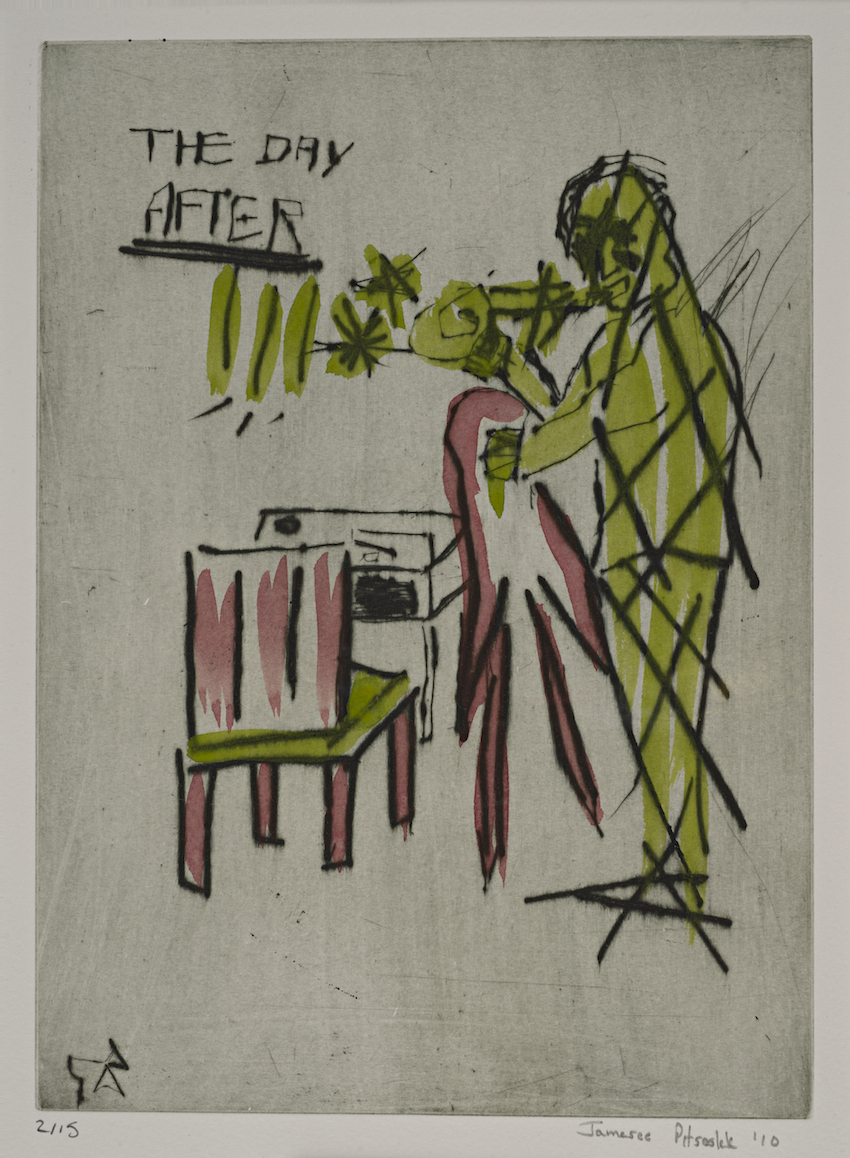
Jamasie Pitseolak (Inuit, Cape Dorset, Canada, b. 1968)
The Day After, 2010
Hand-painted dry-point etching, 2/15
19.5 x 15 inches
Reproduced with the permissions of Dorset Fine Arts
“I had to burst the bubble. And when it did, it just broadened my vision of where I want to go from there.”
— Jamasie Pitseolak
Jamasie Pitseolak’s family consists of many artists, especially carvers, who have all influence his body of work. In his beginnings as an artist himself, Pitseolak participated in traditional forms of sculpture, with regard to specific images and media. However, he did not receive sufficient personal and artistic satisfaction through these modes, which then compelled him to move beyond and explore alternative themes, such as in The Student and The Day After.
In this pairing , Pitseolak moves away from carving and changes his choice of medium to that of a work on paper. Through a dialogue between the two works, he explores his personal experience of abuse in Canadian Indian Residential School System. These colonial schools systems were founded with the intention to annihilate Indigenous existence. In this genocidal process, Indigenous children were forcibly removed from their home communities in order to eradicate their ‘Indianness.’ Often, non-Native authority figures targeted them with physical, mental, and sexual abuse. In both his carvings and these two drawings, the artist, as he has stated, creates the works of art for himself – he’s “not doing it for anyone else.” While he previously typically made art as a means of personal enjoyment, The Student and The Day After stray away from that practice and serve to grapple with this traumatic past, his reality – the colonial reality.
The Student represents young Pitseolak in a bathtub at the residential school with an adult, presumably a teacher. He utilizes a pallid red on Pitseolak, a repulsive green on the adult’s eyes, chest, and genitals, and harsh diagonal slashes. Although The Day After shares the same colors and slash features, comparatively it is more abstract and also contains text. Pitseolak depicts the outline of the representation of his younger self in the red, being gripped by the adult who is now completely green, covered with the hash marks and yelling at Pitseolak. The words, “The Day After,” are scratched above a desk and chair and literally mark a history hidden by the West.
The use of bold colors and text in The Day After in relation to The Student makes both Pitseolak and the audience confront his reality, as well the history of abuse in the residential school system. He portrays the unbalanced power dynamic between the two by physical size, positionality and the explicit physical control the adult exerts over the child. In both, the teacher appears much larger than Pitseolak, and in The Student, the teacher extends his gaze onto him, naked and vulnerable with his back turned. While these artistic choices unsettle a violent colonial past, Pitseolak’s decision to create these works also serves as an explicit assertion of his perspective. His assertion urges the viewer to recognize and confront the trauma of the residential school systems.
Maggie López ’14 & Jesse Peters ’14
